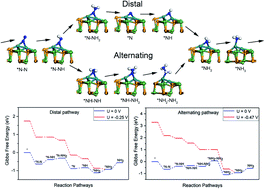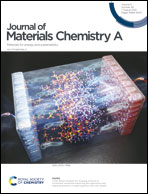Activation of phosphorene-like two-dimensional GeSe for efficient electrocatalytic nitrogen reduction via states filtering of Ru†
Abstract
A nitrogen reduction reaction (NRR) which converts nitrogen (N2) to ammonia (NH3) normally requires harsh conditions to break the bound nitrogen bond. Herein, via first-principles calculation it is revealed that a superior NRR catalytic activity could be obtained by anchoring an atomic catalyst above the phosphorene-like puckered surface of germanium selenide (GeSe). By examining the single- and double-atoms (B, Fe, Mo Ru and W) decorated on GeSe, it is found that its rippled structure allows an intimate contact between the deposited species and the GeSe which significantly promotes the states hybridization. Out of all the various atomic catalysts, it is found that the Ru dimer decorated GeSe monolayer (Ru2@GeSe) has superior catalytic activity for the N2 fixation and reduction. By examining the three NRR pathways (distal, alternating and enzymatic), it was found that the distal and enzymatic pathways are both thermodynamically favorable with the maximum Gibbs free energy change (ΔGMAX) of 0.25 and 0.26 eV, respectively. Such a superior activity could be attributed to the Ru dimer filtering the states of GeSe which leads to the effective activation of the adsorbed N2 bond. As an efficient near-infrared absorber of GeSe, the Ru mediated hybridization of the GeSe–Ru–N2 complex enables an in-gap state which further broadens the absorption window, rendering for a broadband solar absorption and possible photocatalysis.



 Please wait while we load your content...
Please wait while we load your content...